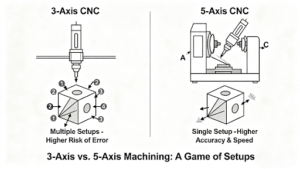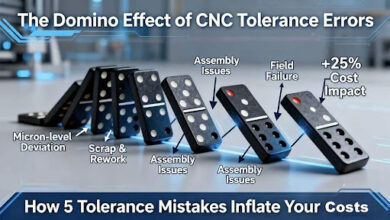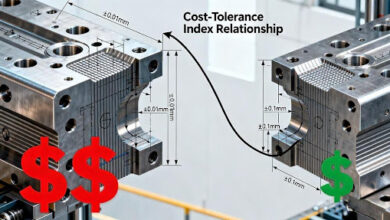CNC Outsourcing: Avoid These 3 Costly Mistakes to Slash Your Manufacturing Budget by 30%

Introduction
A recent study by the Society of Manufacturing Engineers (SME) suggests that poor supplier selection can inflate the total cost of a manufactured component by up to 30%, factoring in rework, delays, and operational disruptions. Imagine this: you’ve received a seemingly competitive quote for a critical CNC machining component, only to discover later that communication gaps with the supplier lead to misunderstandings, requiring expensive design changes and pushing your product launch past a crucial market window.
This scenario underscores a critical flaw in how many businesses approach outsourcing—focusing solely on the unit price rather than the Total Cost of Ownership (TCO). True cost efficiency isn’t about finding the cheapest supplier; it’s about identifying a partner whose capabilities, systems, and communication style align with your project’s goals to minimize risk and maximize value over the entire project life cycle. This guide will dissect three often-overlooked factors that fundamentally impact your TCO.
How to Accurately Decode a CNC Machining Quote?
A transparent CNC machining quote is your first line of defense against budget overruns. It should be a clear breakdown, not a vague lump sum. The unit price is just the tip of the iceberg.
Key Line Items to Scrutinize
When reviewing a quote, move beyond the bottom line. Scrutinize these elements:
- Setup/CAM Programming Costs:
This is a one-time fee for preparing the machines. For small batches, it can constitute a significant portion of the cost. Understand if it’s a fixed fee or amortized across the units. - Material Specification:
Is a premium-grade material specified where a standard grade would suffice? A knowledgeable supplier should provide DFM (Design for Manufacturability)feedback to optimize material choice without compromising function. - Machine Time Estimate:
This is based on the complexity of the part and the chosen machining process. Quotes for parts with deep pockets or thin walls will typically show higher machine time due to slower, more precise operations needed to prevent tool breakage or part deformation. - Surface Finishes and Secondary Operations:
Each additional finish, like anodizing or plating, adds cost and time. Ensure each finish is necessary for the application. - Quality Control Measures:
Does the quote include first-article inspection, full CMM reporting, or statistical process control? These are not optional extras for precision parts; they are essential for risk mitigation.
The True Cost of “Too Good to Be True” Pricing
An exceptionally low quote should be a red flag, not a victory. It often signals corner-cutting in critical areas:
-
- Inferior Materials:
The supplier may be using off-spec or non-traceable materials to reduce costs, jeopardizing the part’s mechanical properties and longevity. - Outdated Equipment or Processes:
Less efficient machinery can lead to longer lead times and potentially higher energy consumption, negating initial savings.
- Inferior Materials:
- Lax Quality Control:
Skipping rigorous inspections increases the risk of receiving non-conforming parts, leading to costly production line stoppages or, worse, field failures. The cost of a single failed part in an assembled product can dwarf the savings from a cheap unit price.
Case in Point:
A medical device startup received two quotes for a stainless steel housing. Supplier A’s quote was 25% lower than Supplier B’s. Supplier A’s quote was a single line item; Supplier B’s included a detailed breakdown, noting a potential risk of distortion in a thin-walled section and proposing a modified machining strategy. The startup chose Supplier A. The first batch arrived with warped parts, causing a six-week delay and over $15,000 in scrap and expediting fees—erasing any initial savings.
What Certifications Truly Guarantee Quality in Precision Machining?
Certifications are more than badges on a website; they are independent validations of a supplier’s commitment to systematic quality management. Understanding what they represent is key to assessing reliability.
Beyond the Badge: What ISO 9001 Really Means for Your Project
ISO 9001 is the international benchmark for Quality Management Systems (QMS). Its core principle is not about creating perfect parts every time, but about having a system that ensures consistency, tracks performance, and drives continuous improvement. For you, the customer, this translates to:
- Process Standardization:Every order, from a single prototype to a large production run, follows a documented process, reducing variability.
- Corrective and Preventive Action:When a non-conformance occurs, the supplier is required to not just fix the immediate issue but to investigate the root cause and implement measures to prevent its recurrence. This reduces the risk of repeat errors.
- Traceability:Materials and processes are documented, allowing any issue to be traced back to its source. This is invaluable for compliance and field failure analysis.
According to the International Organization for Standardization, the adoption of a process-based QMS like ISO 9001 helps organizations “enhance customer satisfaction” and “achieve consistent conformity to customer and applicable statutory and regulatory requirements.”
Industry-Specific Certifications (e.g., AS9100D for Aerospace)
For highly regulated industries, general certifications are not enough. AS9100D builds upon ISO 9001 with aerospace-specific requirements. Key differentiators include:
- Enhanced Risk Management:Mandates proactive risk assessment throughout the project life cycle.
- Stringent Control of Counterfeit Parts:Requires processes to prevent the use of fraudulent materials.
- Focus on Product Safety:Emphasizes designing and manufacturing for safety from the outset.
Similar sector-specific standards exist for automotive (IATF 16949) and medical devices (ISO 13485). A supplier holding these certifications demonstrates a deep understanding of your industry’s unique challenges and regulatory burdens.
When evaluating a certified supplier, don’t just check the certificate. Ask to see evidence of its implementation: How are internal audits conducted? Can they provide an example of a recent corrective action report (redacted for confidentiality)? How is employee training on quality objectives managed? This due diligence ensures the certification reflects a living culture of quality, not just a framed document.
When Do You Need Advanced Capabilities Like 5-Axis CNC Machining?
Advanced technology like 5-axis CNC machining is not always necessary, but when applied correctly, it can significantly optimize TCO by reducing part count, improving quality, and accelerating production.
Identifying Complex Geometries That Require 5-Axis

Figure 2: The Power of Five-Axis Machining: A single setup on a 5-axis machine can replace multiple setups on a 3-axis machine, improving accuracy and reducing lead time.
Consider 5-axis CNC machining services when your part has:
- Complex Contours:Parts with compound curves or organic shapes, common in aerospace and automotive design.
- Features on Multiple Faces:Components requiring precision machining on several sides that are not parallel/perpendicular. A 3-axis machine would require multiple, time-consuming re-fixturing steps, each introducing potential alignment errors.
- Deep Cavities or Recesses:A 5-axis machine can tilt the cutting tool to access hard-to-reach areas with a shorter, more rigid tool, improving accuracy and surface finish.
For instance, machining a deep pocket with a 3-axis machine might require a tool with a long flute length, which is prone to vibration (chatter), leading to poor surface finish and dimensional inaccuracy. A 5-axis machine can approach the same pocket from an angle, using a standard, more robust tool, ensuring tolerances can be held as tight as ±0.005mm or better.
The Long-Term Value vs. Upfront Cost
While the hourly rate for a 5-axis machine may be higher, its value lies in process consolidation. A single setup on a 5-axis machine can often complete work that would require 3 or 4 setups on a 3-axis machine. This eliminates cumulative fixture errors and drastically reduces lead times. For a more in-depth comparison of the technologies, a detailed guide on Online 5-axis CNC machining service explains the operational advantages and cost-benefit analysis clearly. The key is to view the technology as an investment that reduces touch labor, handling time, and quality risks, often resulting in a lower total cost for complex components.
Case Study: Optimizing an Aerospace Bracket
-
- Background:A manufacturer needed a lightweight titanium bracket with mounting holes on several angled planes.
- Problem:The initial design required manufacturing the bracket as three separate pieces to be assembled, introducing potential failure points and increasing weight.
- Solution:The supplier’s engineering team recommended a redesign for 5-axis-cnc-machining, allowing the bracket to be produced as a single, monolithic part. The 5-axis machine could smoothly approach all angled features without re-clamping.
Before finalizing your partner, a systematic audit is crucial. This goes beyond checking certifications to evaluating operational reality.
Key Areas to Investigate: Equipment, Engineering Support, Communication
Conduct a virtual or in-person audit focusing on:
- Technical Capability:Do they have the right equipment (e.g., 5-axis CNC machining centers for complex work)? Is it well-maintained?
- Engineering Support:This is critical. Do they offer proactive DFM analysis? Will an engineer review your drawings and suggest optimizations for cost, manufacturability, and performance? A “yes” indicates a valuable partner.
- Communication Protocol:Is there a dedicated project manager? What are the expected response times? How are project updates communicated (e.g., through a portal, email)? Clear communication is the antidote to costly misunderstandings.
Ask probing questions: “Can you walk me through your process for handling an engineering change order?” or “How do you ensure the correct revision of a drawing is always used on the shop floor?” The answers will reveal the robustness of their systems.
Red Flags and Green Flags
Vague quotes, reluctance to share references, inability to explain their quality process, high employee turnover, poor communication during the quoting stage. (e.g., The sales contact cannot connect you with an engineering lead for a technical discussion.)
H2: FAQs
Q1: What information should I provide to get the most accurate CNC machining quote?
A: Provide a 3D CAD model (STEP or IGES format), 2D drawings with critical dimensions and tolerances clearly called out, material specification, quantity required, and any desired surface finishes. The more detailed the information, the more accurate the quote and the fewer assumptions the supplier must make.
Q2: What’s the difference between a prototype run and a production run in terms of cost and process?
A: Prototyping prioritizes speed and flexibility. Costs may be higher due to setup time being amortized over fewer parts. The focus is on form, fit, and function. Production runs prioritize efficiency and consistency. The process is optimized for higher volumes, leading to a lower cost per part but requiring more upfront validation to ensure repeatability.
Q3: What are the advantages of working directly with a manufacturer compared to using a middleman or broker?
A: Dealing directly with a source manufacturer, such as LS Manufacturing, eliminates communication latency… This direct relationship often results in faster response times and more insightful engineering feedback.
Q4: My part has very tight tolerances (±0.01mm). How can I be sure a supplier can meet them?
A: Inquire about their quality control equipment. Suppliers capable of holding such tolerances will typically use Coordinate Measuring Machines (CMMs) and will provide comprehensive First Article Inspection Reports (FAIR) with actual measured data for your review before shipping the entire batch.
Q5: What are the benefits of a “one-stop-shop” that offers multiple services like CNC machining, sheet metal, and injection molding?
A: It simplifies supply chain management. You have a single point of contact and responsibility for complex projects involving multiple components. This improves coordination, can consolidate shipping, and often leads to better overall project integration and accountability.
Conclusion
Optimizing your CNC machining outsourcing is a strategic exercise in evaluating Total Cost of Ownership. By looking beyond the unit price to deeply assess a supplier’s quoting transparency, the substantive meaning of their quality certifications, and their strategic use of technology like 5-axis CNC machining, you empower yourself to make decisions that truly protect your budget and timeline. Use the audit framework provided not as a one-time checklist, but as a living tool to evaluate and select a manufacturing partner that drives your business forward through reliable, high-quality production.
Author Bio
This article is contributed by Joe Zhang who is the Director of Engineering at JS Precision, a certified ISO 9001 and AS9100D precision manufacturing partner which specializes in helping medical, aerospace, and industrial OEMs optimize the Total Cost of Ownership for critical components. To deepen your expertise, explore their technical blog for more insights on DFM, machining strategies, and supply chain management.



